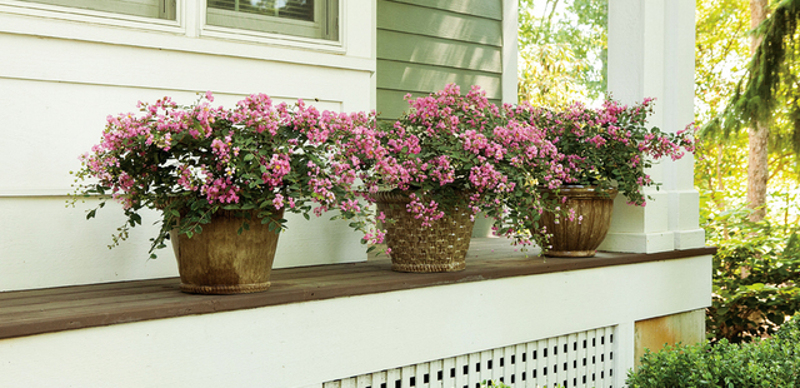Crape Myrtle is a perennial that grows in USDA zones 7 through 9. This shrub thrives in sunny areas with increased humidity, making it a staple of landscapes throughout the south. The easy-to-grow nature coupled with the lovely flowers that bloom throughout the summer are the most appealing traits of this upright, tree-like plant. Crape Myrtle is commonly used to provide color or shield an area, creating privacy.
Growing Crape Myrtle in pots creates more opportunities to feature the plant in different areas, like a patio, balcony, front porch, and other growing zones. There are many varieties of Crape Myrtle available, and many can grow very large. Small or dwarf varieties are usually a better fit for growing in containers. Learn more about growing Crape Myrtle in pots.

Planting Crape Myrtle in Pots
Spring is the best time of year to plant Crape Myrtle. This shrub is deciduous so getting it planted at the start of the growing season ensures it can acclimate before going dormant. Place the container in a spot that receives direct sunlight. This plant can handle the demanding afternoon sun, which many plants cannot, so feel free to place the container in a bright area.
The proper container will have drainage because this plant likes moist soil, but it cannot tolerate soggy conditions. Allowing excess water to drain is essential. Any type of pot material will work but note that porous materials, like terracotta and unglazed ceramic, will allow moisture to evaporate so that the soil will dry out more quickly. Planting Crape Myrtle in a container made from a porous material is completely fine if that is the look you want, but it will mean the plant may need water more often.

Best Soil For Crape Myrtle in Pots
Crape Myrtle is known for handling any soil type, including low-quality soil. However, using rich soil amended with organic material will help the plant thrive. The ideal soil will hold some moisture but allow excess water to drain. Crape Myrtle likes slightly acidic soil with a pH of 5.0 - 6.5.
Caring For Crape Myrtle in Planters
Growing Crape Myrtle in a container makes it possible to feature this flowering shrub on decks, balconies, or other areas. This tree-like shrub can grow very tall, depending on the cultivar, so try to select a variety that will top out around 3 to 4 feet. Crape Myrtle prefers bright sunlight and rich, slightly acidic soil. The container should match the aesthetic of your space, but it should also have drainage. Keep in mind that planters made from porous materials will allow the soil to dry out quickly, so the plant may require more frequent watering.
Watering Crape Myrtle in Pots
Potted plants need water more often because the soil dries out more quickly. Crape Myrtle is drought-tolerant once established when grown in the ground, but container-grown plants will consistently need water during the growing season. Water potted Crape Myrtle when the top several inches of the soil is dried out. The conditions and weather will determine when the plant needs water, but plan on watering potted Crape Myrtle once or twice a week. The plant may need water more often during a dry spell.

Fertilizing Crape Myrtle in Pots
It is essential to fertilize plants in pots because the soil is naturally stripped of nutrients when the plant receives water. Applying plant food helps replenish the nutrients and supports healthy growth. Potted Crape Myrtle will benefit from using a balanced fertilizer every other week. Water-soluble fertilizers are a good choice for potted plants because the plant food can be included as part of the watering routine.
Winter Care For Crape Myrtle in Pots
Crape Myrtle is a deciduous shrub, so the flowers and foliage will naturally fall away during the fall and winter, and the plant will go dormant. Not much winter care is required, although it can be helpful to move the plant to a protected area, like near a building. Crape Myrtle can handle outdoor living in USDA zones 7 through 9, but if grown in northern climates, the plant will need to be moved to an indoor area for the winter.
The ideal winter home will be protected from the elements and not experience freezing temperatures. If exposed to frigid temperatures, the roots can be damaged, so move the plant to a basement or a space that will not freeze.
Growing Crape Myrtle Indoors
Crape Myrtle is not the best houseplant because it is deciduous. The leaves drop in the fall, and this shrub will have bare branches throughout the winter, so it is not visually appealing. This plant needs a break and takes the fall and winter to regroup and prepare for the next growing season. Due to its dormancy, potted Crape Myrtle plants are not typically brought into a living area during the winter.
 |
Author Alison Cotsonas - Published 25-01-2022 |
